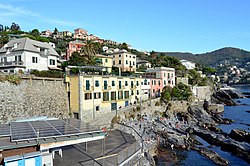
The Italian Riviera or Ligurian Riviera is the narrow coastal strip in Italy which lies between the Ligurian Sea and the mountain chain formed by the Maritime Alps and the Apennines. Longitudinally it extends from the border with France and the French Riviera near Ventimiglia eastwards to Capo Corvo which marks the eastern end of the Gulf of La Spezia and is close to the regional border between Liguria and Tuscany. The Italian Riviera thus includes nearly all of the coastline of Liguria. Historically the "Riviera" extended further to the west, through what is now French territory as far as Marseille.

Liguria is a region of north-western Italy; its capital is Genoa. Its territory is crossed by the Alps and the Apennines mountain range and is roughly coextensive with the former territory of the Republic of Genoa. Liguria is bordered by France to the west, Piedmont to the north, and Emilia-Romagna and Tuscany to the east. It rests on the Ligurian Sea, and has a population of 1,557,533. The region is part of the Alps–Mediterranean Euroregion.

Recco is a comune in the Metropolitan City of Genoa, region of Liguria, Italy. It is known for its focaccia con il formaggio which is made with stracchino. The consortium that dictates the official recipe of the focaccia, supposedly the result of a Saracen attack in the 13th century, has obtained the European Union PGI status for the recipe.

Arenzano is a coastal town and comune in the Metropolitan City of Genoa, Liguria, northern Italy, facing the Ligurian Sea. As of 2017, it has a population of 11,445. This varies during the holiday seasons due to tourist flow.
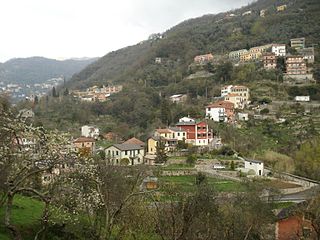
Avegno is a comune (municipality) in the Metropolitan City of Genoa in the Italian region of Liguria, located about 20 kilometres (12 mi) east of Genoa.
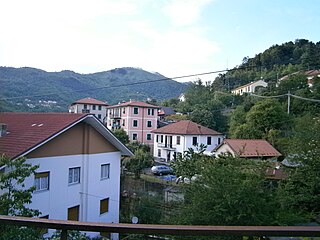
Bargagli is a comune (municipality) in the Metropolitan City of Genoa in the Italian region Liguria, located about 14 kilometres (9 mi) northeast of Genoa in the Val di Lentro.

Bogliasco is a comune (municipality) in the Metropolitan City of Genoa in the Italian region Liguria, located about 11 kilometres (7 mi) southeast of Genoa. Together with the comuni of Camogli, Recco, Pieve Ligure and Sori, it is part of the so-called Golfo Paradiso. Economy is mostly based on tourism; agriculture include production of olives.
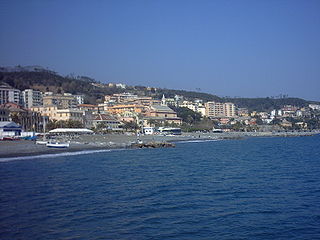
Cogoleto is a comune (municipality) in the Metropolitan City of Genoa in the Italian region Liguria, located about 25 kilometres (16 mi) west of Genova. Its territory extends from the sea to the Ligurian Apennines; it is part of the Natural Regional Park of Monte Beigua.

Lumarzo is a comune (municipality) in the Metropolitan City of Genoa in the Italian region Liguria, located about 15 kilometres (9 mi) east of Genoa.

Moneglia is a comune (municipality) in the Metropolitan City of Genoa in the Italian region Liguria, located about 50 kilometres southeast of Genoa. It is a tourist resort on the Riviera di Levante. In 2012 it was added to the list of I Borghi più belli d'Italia.
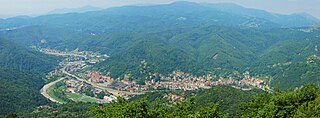
Ronco Scrivia is a comune (municipality) in the Metropolitan City of Genoa in the Italian region Liguria, located about 20 kilometres (12 mi) north of Genoa.

Sori is a comune (municipality) in the Metropolitan City of Genoa in the Italian region Liguria, located about 17 kilometres (11 mi) southeast of Genoa. Together with Camogli, Pieve Ligure, Bogliasco, and Recco, it is part of the so-called Golfo Paradiso in the Riviera di Levante. Its economy is based on tourism and production of olives.

Monte Penello is a mountain in Liguria, northern Italy, part of the Ligurian Apennines. It is located in the province of Genoa. It lies at an altitude of 995 metres.

Monte Reixa is a mountain in Liguria, northern Italy, part of the Ligurian Apennines.

The Church of Saint Anne, with the adjacent convent and pharmacy of the Discalced Carmelites, is a Roman Catholic church located in the residential quarter of Castelletto in Genoa, Liguria, north-western Italy. The village - now surrounded by the city - is still intact, with its leafy trees, cobbled walkways and open views from Salita Bachernia over the Gulf of Genoa, the harbor and the Old City.

Trofie is a short, thin, twisted pasta from Liguria, Northern Italy.

The Metropolitan City of Genoa is one of the fourteen Metropolitan cities of Italy, located in the region of Liguria. Its capital is the city of Genoa. It replaced the Province of Genoa.

Genoa is a city in and the capital of the Italian region of Liguria, and the sixth-largest city in Italy. In 2023, 558,745 people lived within the city's administrative limits. While its metropolitan area has 813,626 inhabitants. Over 1.5 million people live in the wider metropolitan area stretching along the Italian Riviera.

The term Great Genoa refers to the present area of the municipality of Genoa, in the north west of Italy. Great Genoa extends for over 30 km along the coast of Ligurian Sea from Nervi to Voltri, and up the Polcevera valley of the Polcevera river and the Bisagno river valley of the Bisagno river.
Prescinsêua is a variety of cheese typical of the province of Genoa in the region of Liguria in Italy. In Italian it is also referred to as quagliata or cagliata. It is recognised by P.A.T. .
